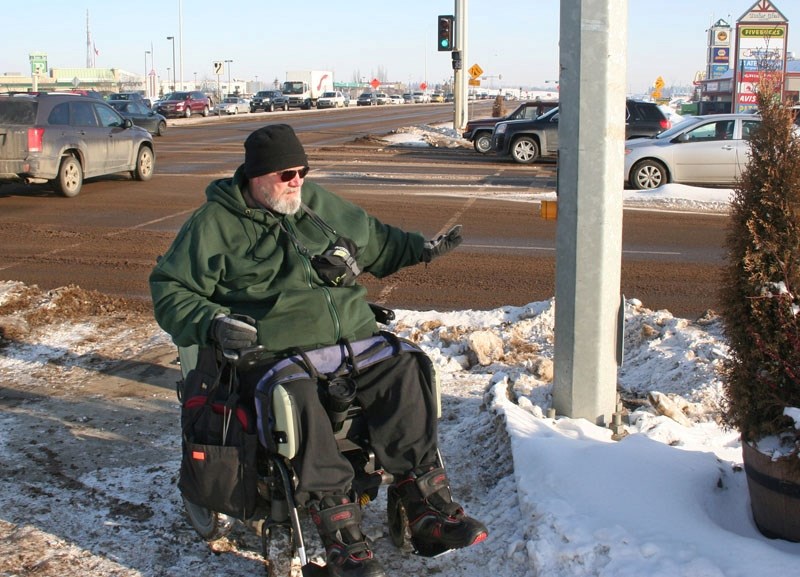It has been a pretty awful winter for snowfall, the worst in decades by many accounts.
The city's street clearing budget has been thrown and obliterated like snowballs against a brick wall, with $2.65 million used up and still the flakes keep coming.
Darrell Symbaluk, municipal operations supervisor with the city's public works department, doesn't even need specific measurements. We all know the state of affairs.
"We've gotta be up there in terms of the high end of what we see in a season," he said of the amount of snow. "I guess the challenge this year would've been in the amount of time that we received it. If you've got time in between storms it's more of a manageable thing."
Time was not on our side but St. Albert's streets were still the envy of other municipalities in the area. Turning corners around a great dune of plowed and piled snow is an exercise in stress management and X-ray vision. Many roadways have narrowed so much that even major boulevards can only handle cars from one direction at a time. It's a good thing that drivers are so accommodating with each other in these circumstances, letting others pass in exchange for a friendly wave.
Polite manners apparently have no place on the city's other roadways, though.
The path of most resistance
Murray Barker is one of the city's most fervent observers of sidewalk conditions and well he should be. He's been in a wheelchair for a decade now but still prefers to get out of the house each day for fresh air. The sidewalks are his streets but they aren't cleared with him in mind.
"You understand that the vast volume of traffic and anywhere … the automobile is the major way that people move around."
When it comes to snow clearing, he feels cars get first priority over pedestrians. Despite his last name the former police officer is as affable as they get, an easy-going guy with a civic conscience. He volunteers on the board of the seniors' club. He is a man about town. Sitting still isn't his cup of tea. At one point he didn't leave his house for three days: he just couldn't go anywhere.
"I guess with snow removal, everybody is trying to save a buck," he said with an air of complete understanding.
Even though his department doesn't deal with complaints about sidewalks in residential areas, Symbaluk knows what it's like out there.
"I've heard quite a few of them this year. It seems to be more than others."
Barker added his perspective on the city as a whole. When the city clears any snow, there's one eye on the bottom line.
"I think they're trying to save the blades or the concrete … they don't grade right down to the surface. That gets hard for wheelchairs."
Even for chairs like his, something he describes as "robust." It looks sturdy with thick rubber wheels and an imposing profile. Yet it's still a chair and no match for any length of concrete walkpath pockmarked with packed snow and slippery ice patches.
Riding a mile in his shoes
According to the city, there hasn't really been a noticeable increase in the number of bylaw complaints about homeowners who haven't cleared their walks within a reasonable timeframe.
"Sidewalks have posed a challenge with this kind of volume of snow over the winter. We've seen that in-house for the public sidewalks as well as the residential areas," Symbaluk observed.
Empirical observations might lead people, Barker in particular, to another conclusion.
He has seen many places that have either gone unshovelled or with a path too narrow for his chair to pass. Often now is pushed onto the road, leaving an impassable ridge from street to curb. On city sidewalks snow is often piled up around traffic standards, leaving crosswalk request buttons unreachable.
"I see old ladies and everybody else climbing up on the mounds of snow to get to the actuator light but in a wheelchair, you just can't."
During a 30-minute walkabout between the four shopping areas at the city's entrance along St. Albert Trail, Barker could only use small sections of sidewalk. Frequently he was on driveways and drivepaths.
To him, it's more than just a nuisance.
"It's not that the city's alone in that kind of thing. If there's not a sidewalk, you have to say, 'How am I going to get from A to B?' You have to go the long way around sometimes. Most times!"
His frustration is understandable when you sit in his driver's seat for a minute.
City facilities plan for change
While people in wheelchairs might be the last ones to get considered in Barker's estimation, at least some things are changing.
The Art Gallery of St. Albert is also looking to replace or adapt the front steps of the historic 90-year-old Banque d'Hochelaga building to make it wheelchair accessible.
Frances Gagnon, director of arts, said, "I know it's slated in the city's budget for projects that they're committed to in the next couple of years. It's not an easy fix."
The problem is compounded by issues of preservation and equality. A wheelchair accessible bathroom is also part of the plan.
With all of the struggles he faces just getting around, Barker remains jovial and hopeful.
"I'd feel really good about that. I can see the changes happening and it's appreciated. They're doing their best. It costs a lot of money to retrofit places. I'd just like to see that when they build something new, they make sure it's accessible."




